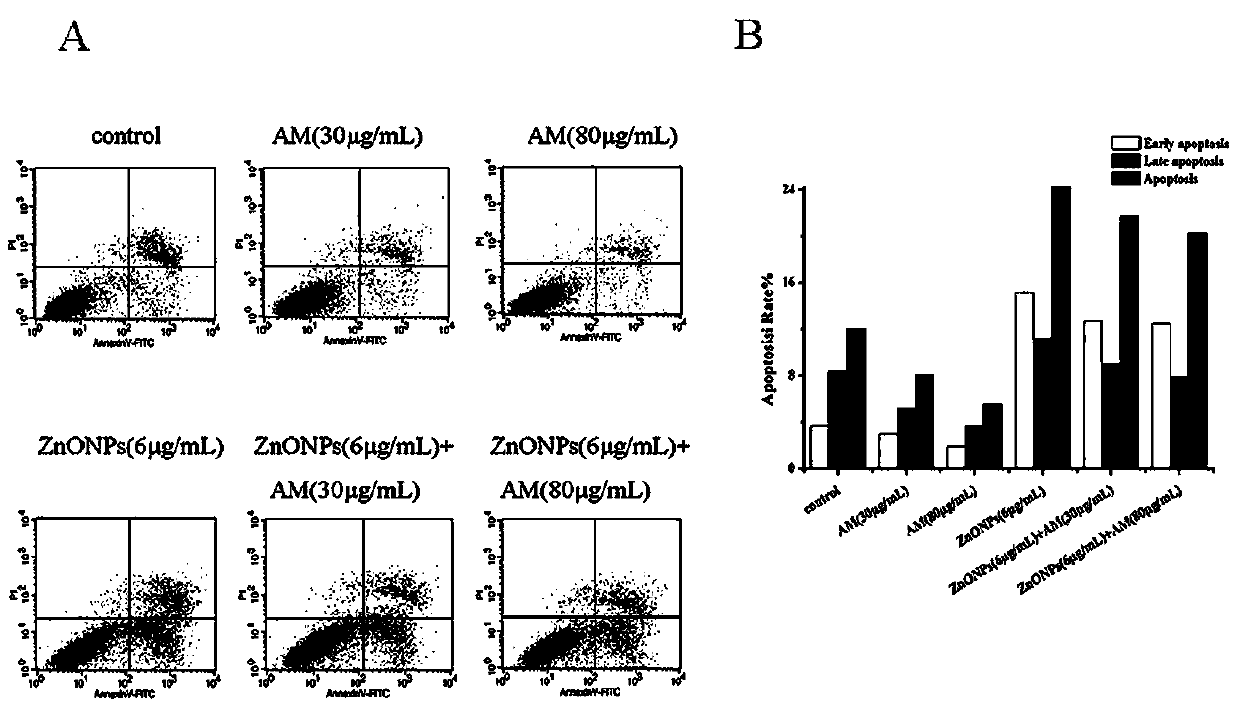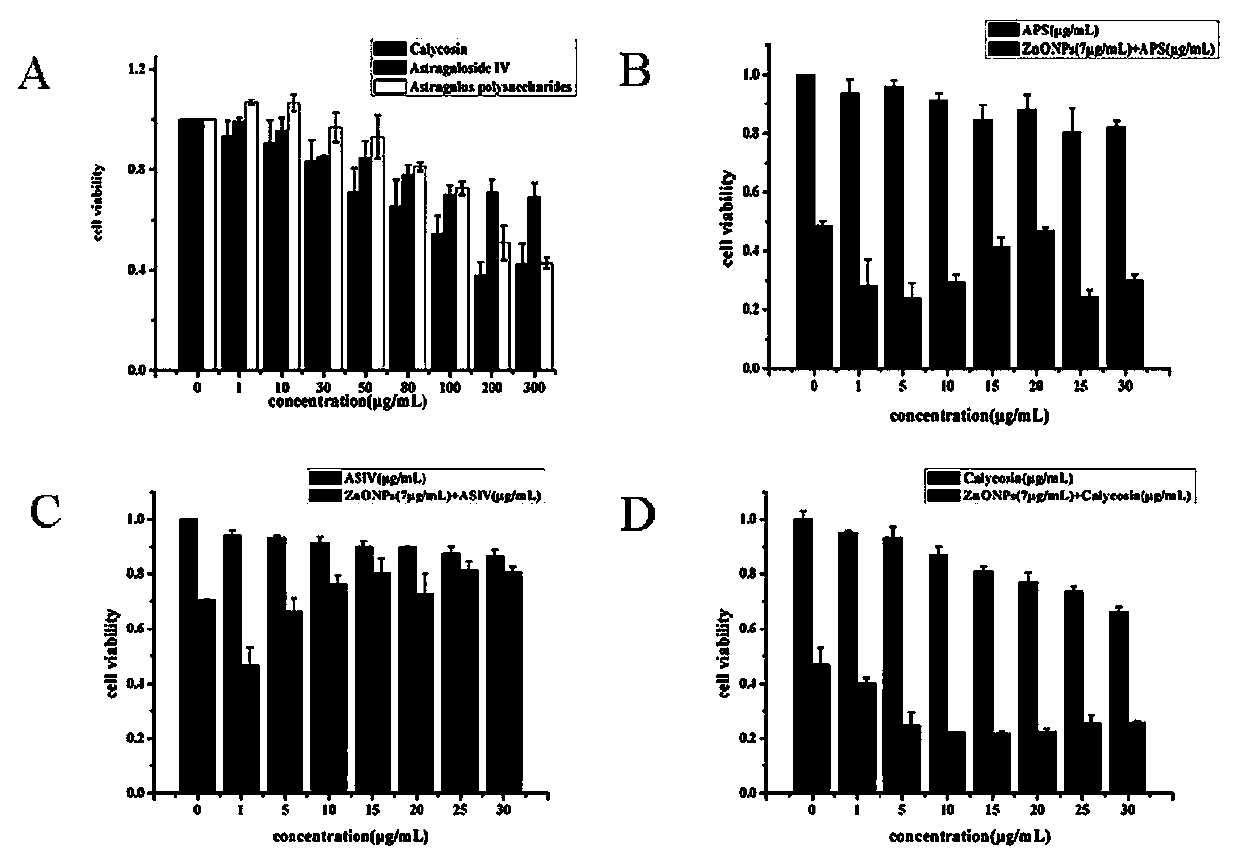Application of astragaloside IV in reduction of nanometer zinc oxide-induced neurotoxicity
A technology of nano-zinc oxide and astragaloside IV is applied in nervous system diseases, medical preparations containing active ingredients, organic active ingredients, etc. It can solve problems such as no research reports on astragaloside IV, and achieve good medicinal prospects, Good pharmacological effect and low toxicity
- Summary
- Abstract
- Description
- Claims
- Application Information
AI Technical Summary
Problems solved by technology
Method used
Image
Examples
example 1
[0032] Astragalus has protective effects against neurotoxicity induced by ZnONPs
[0033] CCK method was used to detect the survival rate of SH-SY5Y cells, and Annexin V-FITC / PI was used to detect cell apoptosis: as follows, different concentrations of ZnONPs (0-7 μg / mL, 8 concentrations), different concentrations of Astragalus (0, 10 , 30, 50, 80, 100, 200 μg / mL); nano-zinc oxide (7 μg / mL) and different concentrations of Astragalus acted on SH-SY5Y cells for 24 hours to detect the effect on cell viability. The concentration of Astragalus membranaceus (30, 80 μg / mL) and nano zinc oxide (6 μg / mL) were selected to intervene the cells for 24 hours, and the apoptosis was detected. Experimental results such as figure 1 As shown in A, in the figure, the label AM is Radix Astragali. After 24 hours of different concentrations of ZnONPs acting on the cells, the cells have obvious inhibitory effect. When the nano-zinc oxide is 7 μg / mL, the cell survival rate is about 65%, 8 μg / mL , th...
example 2
[0035] Astragaloside IV has a protective effect on neurotoxicity induced by ZnONPs
[0036] Adopt CCK8 method to detect SH-SY5Y cell survival rate: specifically as follows, implementation method is the same as example 1, adopts astragaloside IV of different concentrations, astragalus polysaccharide, calycosin (0,1,10,30,50,100,200,300 μ g / mL, 8 concentrations) to detect the impact on cell viability; select the concentration range (0-30 μg / mL) with cell viability greater than 80% to carry out the protection experiment, and the implementation method is the same as in Example 1. Experimental results such as image 3 As shown in A, different concentrations of astragaloside IV, astragalus polysaccharide, and calycosin acted on the cells for 24 hours had obvious inhibitory effect on the cells. About 85.3%, 96.8%, 83.7%, and at 300 μg / mL, the cell viability was about 69.4%, 42.8%, 42.6%, respectively. Choose the concentration of the three components at 1-30 μg / mL to intervene with...
example 3
[0038] Astragaloside IV can induce autophagy
[0039] Western blot method was used to detect the content changes of autophagy-related proteins in SH-SY5Y cells before and after the treatment of astragaloside IV. , 12h) and ZnONPs (5μg / mL) co-acting cells, using Western blot method to observe the changes in the content of autophagy proteins in the cells; 15, 30 μg / mL), ZnONPs (5 μg / mL), the two work together to intervene nerve cells respectively, and observe the changes in the content of autophagy proteins in cells by Western blot. Such as Figure 4 As shown, by Western blot detection of LC3 type conversion, the change of p62 found that compared with the effect of ZnONPs alone, the intracellular p62 showed a down-regulation trend, the expression of LC3-Ⅱ type was up-regulated, and Beclin1 showed an up-regulation trend, which proved that Astragalus A The joint action of glycosides and ZnONPs can enhance the induction of autophagy, and the degree of autophagy increases with the...
PUM
 Login to View More
Login to View More Abstract
Description
Claims
Application Information
 Login to View More
Login to View More - R&D
- Intellectual Property
- Life Sciences
- Materials
- Tech Scout
- Unparalleled Data Quality
- Higher Quality Content
- 60% Fewer Hallucinations
Browse by: Latest US Patents, China's latest patents, Technical Efficacy Thesaurus, Application Domain, Technology Topic, Popular Technical Reports.
© 2025 PatSnap. All rights reserved.Legal|Privacy policy|Modern Slavery Act Transparency Statement|Sitemap|About US| Contact US: help@patsnap.com



